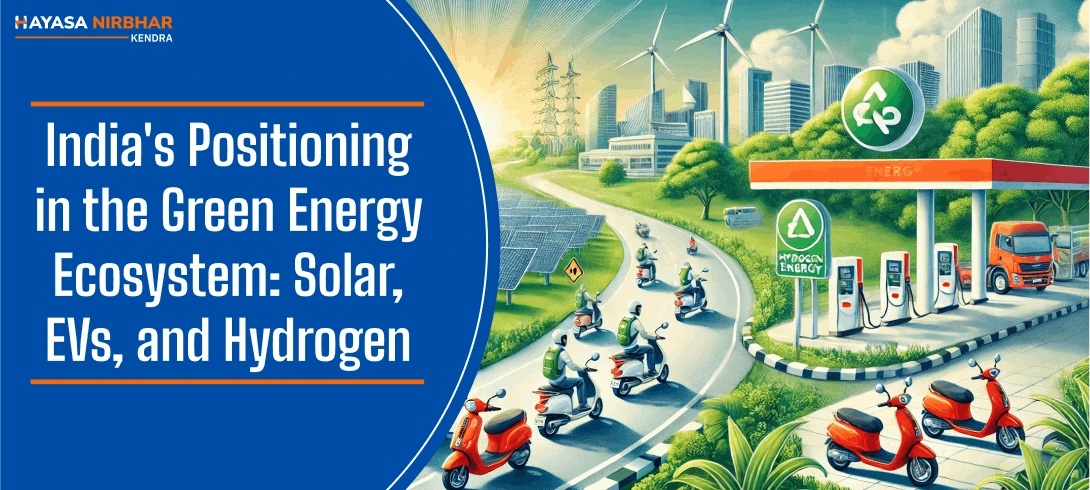
India's Positioning in the Green Energy Ecosystem: Solar, EVs, and Hydrogen
India has become a significant player in the global transition to green energy. The country is making rapid strides in adopting sustainable practices across various sectors, especially in solar energy, electric vehicles (EVs), and hydrogen fuel. With its commitment to reducing carbon emissions and embracing eco-friendly alternatives, India is positioning itself as a key contributor to the green energy ecosystem. Let’s dive into the nation’s progress in these three critical areas.
1. Solar Energy: Leading the Charge in Clean Power
India is one of the largest markets for solar energy in the world, and its growth in this sector has been remarkable. The country aims to meet 50% of its energy needs from renewables by 2030, with solar energy at the forefront of this transition.
- Growth of Solar Power Installations:India’s solar capacity has expanded rapidly, making it the third-largest solar power producer globally. As of 2023, India’s total solar capacity surpassed 60 GW, with the country targeting 300 GW by 2030.
- National Solar Mission: India’s National Solar Mission is a major driver of solar energy adoption, offering incentives for domestic and commercial solar projects. The government’s commitment to solar energy is also seen in its efforts to reduce the cost of solar power production and make solar technology more accessible.
- Solar Parks & Rooftop Initiatives:India has established solar parks across the country, including the world’s largest solar park, Pavagada Solar Park in Karnataka. Additionally, rooftop solar schemes are becoming increasingly popular in urban areas, promoting decentralized power generation.
2. Electric Vehicles (EVs): Revolutionizing Transportation
India's push for electric mobility is gaining momentum, with ambitious goals to reduce dependence on fossil fuels and mitigate urban pollution. EVs are central to India's long-term sustainability strategy, and the country has seen increased investments and innovations in this space.
- Government Support for EVs: The Indian government has launched several initiatives like the Faster Adoption and Manufacturing of Hybrid and Electric Vehicles (FAME) scheme, which provides subsidies and tax incentives to manufacturers and consumers. This has led to a surge in the adoption of electric two-wheelers, three-wheelers, and cars.
- EV Infrastructure Development: As demand for electric vehicles grows, India is actively working on developing EV charging infrastructure across major cities and highways. Companies are investing heavily in setting up fast-charging stations, making EVs more practical for everyday use.
- Manufacturing and Innovation:Leading automakers like Tata Motors, Mahindra, and Ola Electric are at the forefront of EV production in India, developing new models to suit the domestic market’s needs. India is also emerging as a hub for EV manufacturing and battery production, with increasing foreign investment and domestic innovation.
3. Hydrogen: The Fuel of the Future
Hydrogen has gained significant attention as a clean energy source, and India is exploring its potential as a key component of its green energy transition. The country sees hydrogen as an essential element in achieving its climate goals and energy security.
- National Hydrogen Mission: India launched its National Hydrogen Mission in 2021 to accelerate the production of green hydrogen and establish India as a global hub for hydrogen production and exports. The mission aims to reduce hydrogen production costs and enhance the scalability of clean hydrogen technologies.
- Green Hydrogen Projects: Several initiatives are underway to explore green hydrogen as a viable alternative to fossil fuels, especially for heavy industries and transportation. Companies like NTPC and Indian Oil Corporation are already exploring pilot projects focused on hydrogen production.
- Hydrogen Infrastructure Development: India is investing in hydrogen fueling stations and infrastructure to promote the use of hydrogen-powered vehicles, including buses and trucks. The integration of hydrogen into the broader energy mix could play a key role in decarbonizing sectors like steel manufacturing, shipping, and aviation.
Key Takeaways
India’s positioning in the green energy ecosystem is rapidly evolving with significant strides in solar energy, electric vehicles, and hydrogen fuel. These efforts are crucial to achieving the nation’s sustainability and climate goals. The government’s support, growing investment in green technologies, and increasing innovation in these sectors put India on track to play a leadership role in the global green energy transition.
- Solar Energy: India is one of the largest producers of solar power globally, with a target of 300 GW by 2030.
- Electric Vehicles: The government’s support, combined with a growing infrastructure and innovations in the EV market, is transforming India's transportation landscape.
- Hydrogen: India’s National Hydrogen Mission is paving the way for green hydrogen as a viable alternative to fossil fuels, aiming to make India a leader in hydrogen production.
As India continues to invest in these key green energy sectors, the nation is positioned to become a global leader in sustainable energy production and consumption, creating a cleaner, greener future for generations to come.

